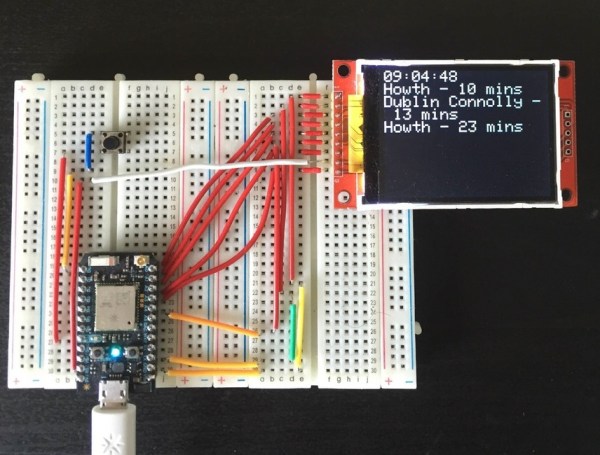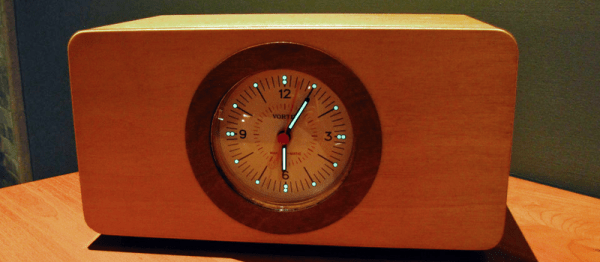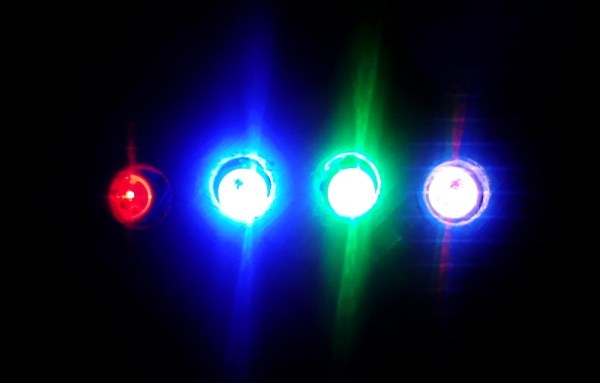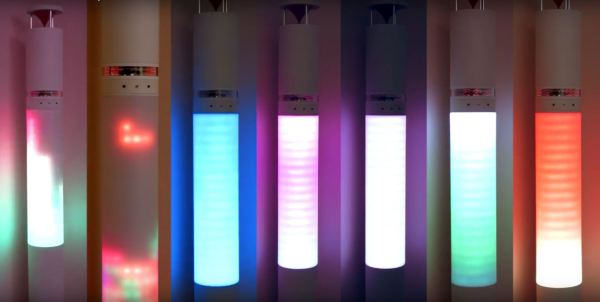Making a clock with a common microcontroller like an Arduino isn’t very difficult. However, if you’ve tried it, you probably discovered that keeping track of wall time is difficult without some external hardware. [Barzok] has a very minimal clock build. It takes a handful of LED arrays with an integrated driver, an Arduino Nano, a real-time clock module, and a voltage regulator.
clock hacks987 Articles
Train Time Ticker Will Save Your Morning Commute
The fatal combination of not being a early riser and commuting to work using public transit can easily result in missed buses or trains. Frustrated with missing train after train while fumbling with a complicated transit schedule app, [Fergal Carroll] created a Train Time Ticker to help his morning routine run right on time.
A Particle Photon hooked up to a 2.2″ TFT screen — both mounted on a breadboard with a button — fit the purpose tidily. Weekday mornings, the Ticker pulls — from a server he set up — the departure times for the specific station and platform along [Carroll]’s commute every three minutes; at all other times, the Ticker can be manually refreshed for any impending trips.
Continue reading “Train Time Ticker Will Save Your Morning Commute”
It’s A Clock! It’s A Puzzle! It’s The GoonieBox!
[Dr.Duino] recently completed the latest piece of what he calls “Interactive Furniture” – the GoonieBox. It took over 800 hours of design and assembly work and the result is fascinating. Part clock and part puzzle box, it’s loaded with symbols, moving parts, lights, riddles, sounds, switches, and locked compartments. It practically begs visitors to take a closer look.
The concept of Interactive Furniture led [Dr.Duino] to want to create a unique piece of decor that visitors could interact with. That alone wasn’t enough — he wanted something that wouldn’t require any explanation of how it worked; something that intrinsically invited attention, inspection, and exploration. This quest led to creating The GoonieBox, named for its twin inspirations of the 1985 film The Goonies as well as puzzles from the game “The Room“.
Embedded below are two short videos: the first demonstrates the functions of the box, and the second covers the build process. There’s laser-cut wood, plenty of 3D printed parts, and a whole lot of careful planning and testing.
Continue reading “It’s A Clock! It’s A Puzzle! It’s The GoonieBox!”
Not Just Another Alarm Clock
Even though [Stefan] sent in this link with the heading “Another Sunrise Alarm Clock“, it’s anything but plain. Sure, from the outside it looks like a simple and refined design, but the story of getting there is hardly straightforward.
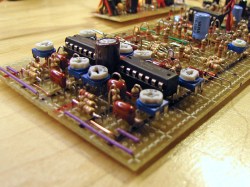 Take that nice-looking luminous dial. [Stefan] made it himself, using the same techniques that he’s used for making his own watch faces. (Amazingly, he prints them out on a color ink-jet.) This is a sunrise wake-up clock, but if the bright LEDs don’t wake him up, there’s also a vintage DIY synthesizer project stuffed in the box in place of a cheap piezo buzzer. Even the wooden case shows attention to detail — it has nice edging done on a router table.
Take that nice-looking luminous dial. [Stefan] made it himself, using the same techniques that he’s used for making his own watch faces. (Amazingly, he prints them out on a color ink-jet.) This is a sunrise wake-up clock, but if the bright LEDs don’t wake him up, there’s also a vintage DIY synthesizer project stuffed in the box in place of a cheap piezo buzzer. Even the wooden case shows attention to detail — it has nice edging done on a router table.
So yeah, we’ve all seen clocks before. But this one is very personal, melding together a few of [Stefan]’s hobbies into one useful, and good-looking, device.
Who Could Resist A Color Coded Clock?
[Luc] wanted to make a clock like no other. He knows that the territory is well-trod, especially in the area of minimalist design. Undeterred, [Luc] came up with a fresh design that uses the resistor color code to display the time. He’s calling it the Nerd’s Ultimate Watch.
It doesn’t get much more minimalist than four RGB LEDs. Each one illuminates in the color that represents the digit in the current time. For instance, I’m typing this sentence at 1:37PM. The clock uses 24-hour time, so let’s call it 13:37. Using resistor color code time, that’s 1, 3, 3, 7, or brown, orange, orange, violet.
Continue reading “Who Could Resist A Color Coded Clock?”
Rubidium Disciplined Real Time Clock
[Cameron Meredith] starts the Hackaday.io page for one of his projects by quoting a Hackaday write-up: “A timepiece is rather a rite of passage in the world of hardware hacking“. We stand by that assertion, but we’d say most of the clocks we feature aren’t as capable as his project. He’s made a real-time-clock module controlled by a rubidium frequency standard, and since it also includes a GPS clock he can track local time dilation effects by comparing the two.
Surplus rubidium standards are readily available, but each description of one seems to feature a lot of old-fashioned hardware hacking simply to get it working. This one is no exception, an unusual connector had to be replaced and an extra power supply module attached. Once those modifications had been made and a suitable heatsink had been attached, he was able to bring the rubidium standard, an RTC module, and GPS module together with an ATMega32U4 miniature Arduino-compatible board and an LCD display. The firmware is functional, but he admits it is not finished.
All the project’s files can be found on the Hackaday.io page linked above. Future plans include also monitoring the NIST WWVB radio time signal from Fort Collins, Colorado, for an extra time dilation comparison.
We’ve featured innumerable clocks over the years here at Hackaday, but among them have been a few based upon atomic standards. More than one has been used as a lab reference standard, but most similar to this build is [Max Carters] experiments to check the accuracy of an atomic standard, also using the WWVB transmissions.
Want To Wake Up In A Ship’s Warp Core? Circadia Sunrise Clock Makes It So
Who among you has difficulty rising in the mornings? Sunrise clocks that simulate a — well, sunrise, are a gentle means of returning to the waking world. [FlorianH], grappling with this very issue, has built his own impressive sunrise clock he has named Circadia. Some sunrise clocks mate an LED with a dev board and call it a day. This work of hardware art will never be confused for something rudimentary.
Standing at 187cm tall, the 8mm thick PCB frame contains three main sections that plug into each other “like Lego”: the top houses a cleverly designed (and virtually silent) propeller clock and a speaker with a 3D-printed, omni-directional reflector. The midsection is reinforced with an MDF column, around which is wrapped 16 strips of 18 RGB LEDs with a heat-molded sheet of acrylic to diffuse the light, while the bottom section has the mid-woofer, the Raspberry Pi 2 brain, most of the electronics, and three switched power supplies.
Built over two years, the primary feature is a variety of themes — with more being added all the time — ranging from rain forest, to arctic, to the warp core of a starship that will rouse you over the course of a half hour. Circadia can also function as a visualizer during a party, or even a Tetris display (a theme that was designed and tested in an afternoon!). Seeing it in action is a treat:
Continue reading “Want To Wake Up In A Ship’s Warp Core? Circadia Sunrise Clock Makes It So”


